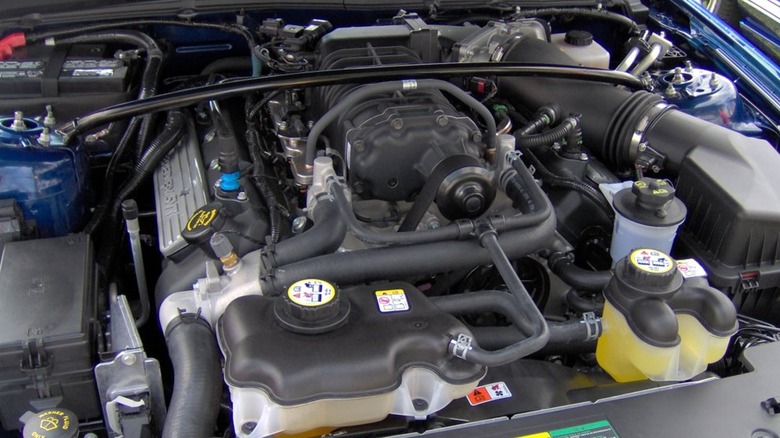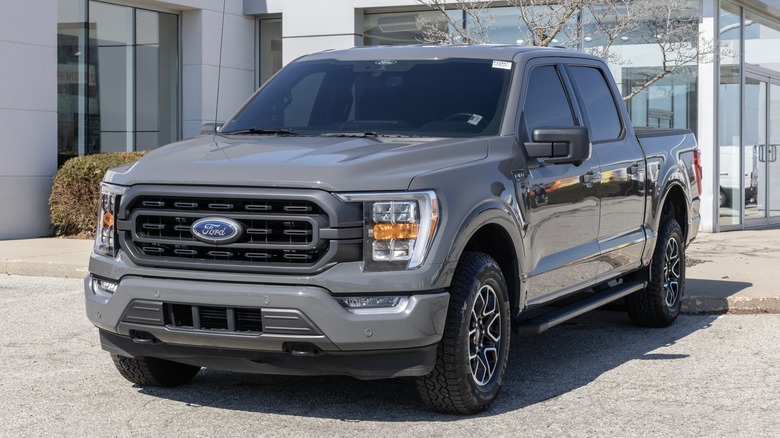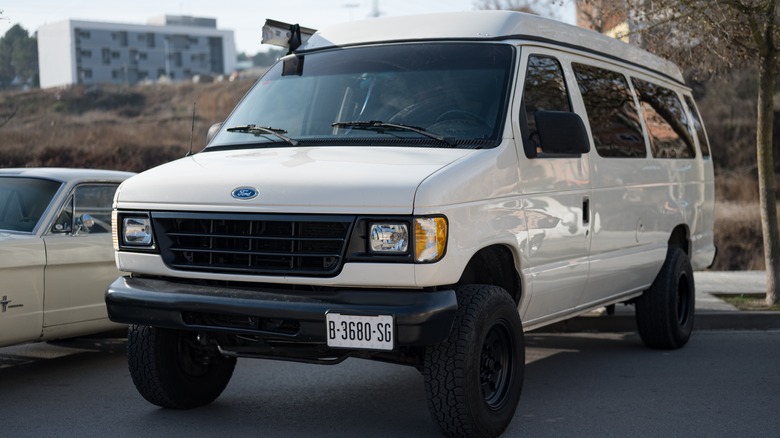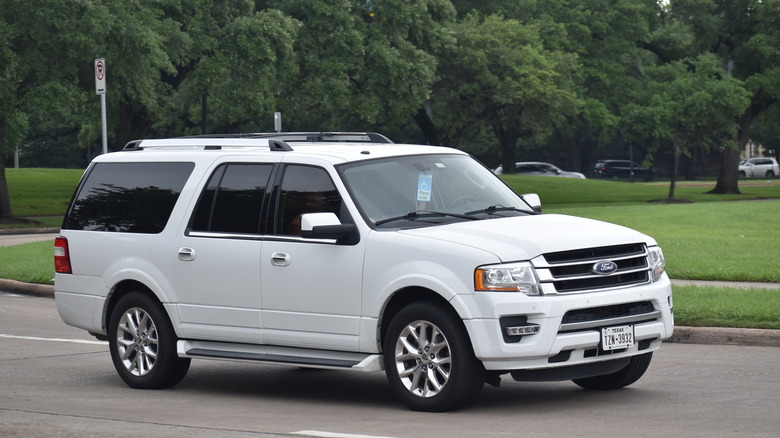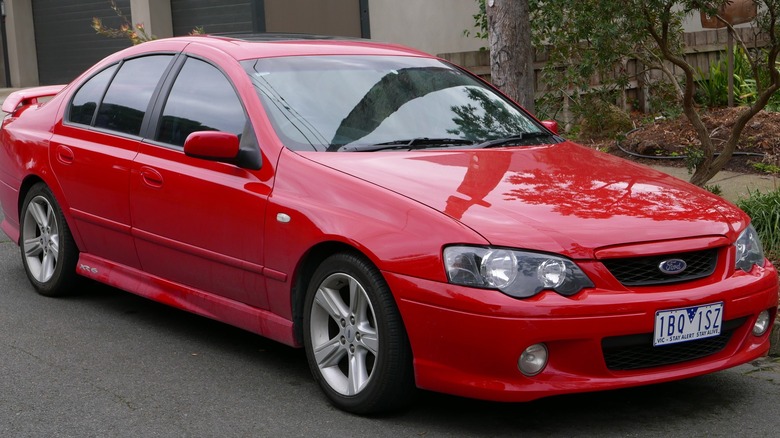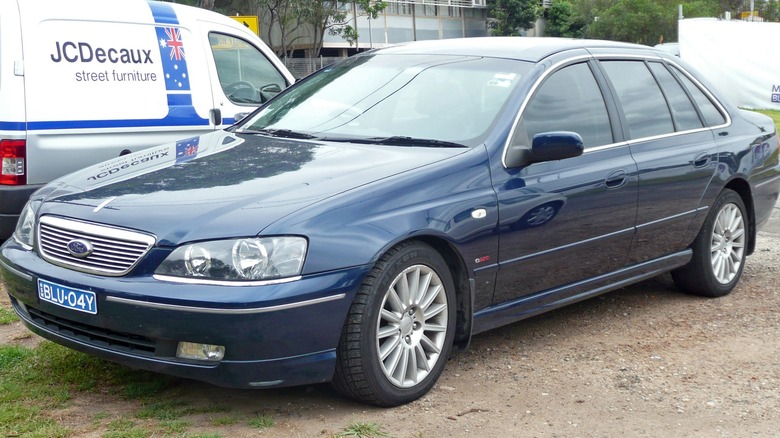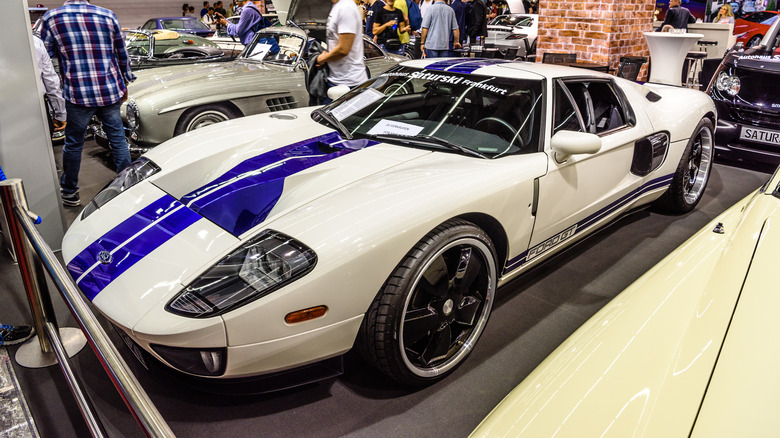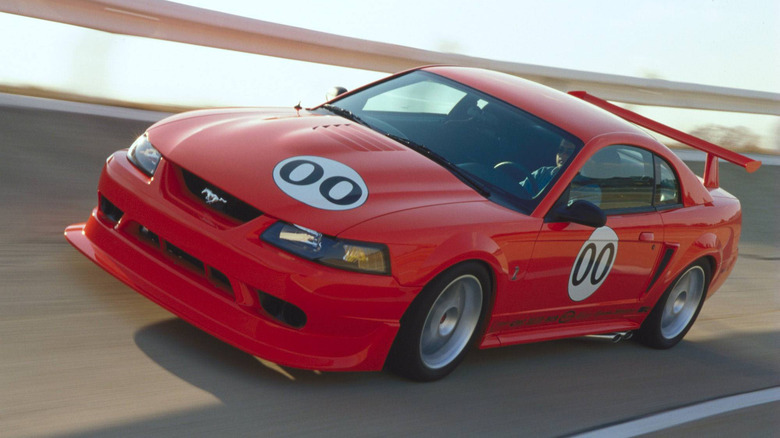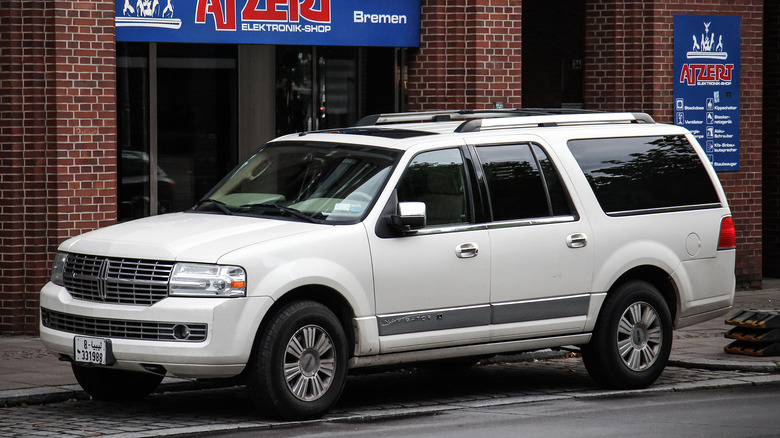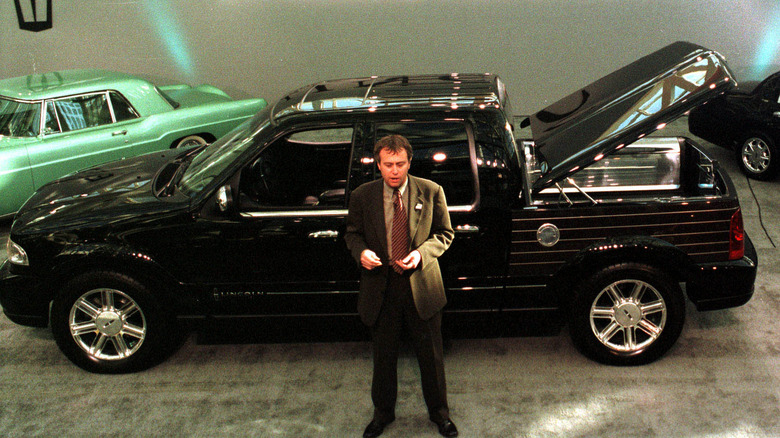Every Ford Model Powered By The 5.4L V8 Engine
With how big of a company Ford is, it's only natural that its engineers and designers would run into some missteps along the way. One such misstep is the 5.4-liter Triton engine, which has gained a poor reputation as the worst engine ever put into a Ford vehicle. Thanks to this reputation, the engine hardly lasted past the 2010s, becoming something you'd be hard-pressed to find in any Ford today. But there's still quite a bit of history behind this engine that's worth looking into.
The 5.4-liter Triton was used in some of Ford's most popular trucks across the world. It was also used in cars that were restricted to overseas markets, and it found a presence in top-performing concept rides thanks to modifications. This could interest some die-hard Ford fans, especially if they want to see just how much potential this engine could've had. On the other hand, anyone looking for a secondhand ride might want to know where this engine was used just so they can avoid it as best as they can. Either way, it's not a bad idea to take a look at every model powered by Ford's Modular 5.4-liter engine.
[Featured image by Stephen Foskett via Wikimedia Commons | Cropped and scaled | CC BY-SA 3.0]
Ford F-Series
During the 1997-2010 model years, Ford's F-Series trucks contained the 5.4-liter Triton engine, taking on the same name as a sleek F-150 concept that never hit the streets. As one might expect, this engine was widely used in many F-150 models, becoming the choice with the highest horsepower available in most cases. It received various improvements and upgrades across generations, with many of its variants reaching over 300 horsepower by 2009. Unfortunately, with its widespread use in F-150s, the 5.4-liter Triton's problems were on full display for the public, with manifold leaks and blown spark plugs plaguing the engine for practically its whole lifespan.
F-150 trucks weren't the only F-Series models to use the 5.4-liter Triton. The F-250 Super Duty also made use of this engine, though it was outclassed in strength by options with larger capacities as of 2010. Still, that allowed it to be the cheapest and most standardized option for Super Duty buyers. The 5.4-liter Triton also found its way into pretty much every other F-Series throughout the early 2000s, including various versions of the 350, 450, and 550. These trucks might be why this engine is put under such scrutiny, but they're also why it managed to attract so much attention in the first place.
Ford E-Series
Much like the F-Series lineup, Ford's E-Series also started to be powered by the 5.4-liter Triton by 1997. This engine lasted a lot longer here than it did in the F-Series, with the E-150 offering it as an option up until its discontinuation in 2014. Other models in the series managed to keep it around for an even longer period of time, with the E-350 boasting the engine through the truck's 2016 model year. Thanks to this selection from Ford, the 5.4-liter Triton was able to enjoy its longest run in any lineup from the company.
Unlike with the F-Series, the 5.4-liter Triton's use in the E-Series doesn't have nearly as much negative press, either. Buyers' guides and community posts refer to the engine as a reliable, if boring choice for the lineup. As one might expect, Ford's modern E-Series lineup has long since let go of this option in favor of bigger 7.3-liter selections. Even so, the presence of the Triton in these vehicles shows a far more positive history than the F-Series.
Ford Expedition
The 5.4-liter Triton's use in the Ford Expedition lands somewhere in between its use in the E-Series and F-series, at least when it comes to longevity. The first year of the engine's use actually coincided with the Expedition's, becoming a part of the SUV from the moment it was made available for purchase. For some time, this engine was even the only one available for newer models. While it lasted for almost 20 years after that, the 2015 Expedition ditched the 5.4-liter V8 for an EcoBoost, ending the engine's run with a more powerful and fuel-efficient option.
One other aspect of the Expedition's 5.4-liter Triton that fell somewhere in between the E-Series and F-Series was reception. Community members have mixed opinions on its use, with some even claiming the engine to be more reliable than the later EcoBoost option. The F-Series consists of Ford's most popular models, so it makes sense that the engine's poor use in those would lead to a generally negative outlook. But the Triton was able to prove how useful it truly could be in models like the E-Series and Expedition, showing there's more to it than its reputation indicates.
Ford Falcon
In the Americas, the Ford Falcon was discontinued long before the 5.4-liter Triton's production. This wasn't the case in Australia, however, where the Falcon name lasted all the way to the 2000s. Once 2002 rolled around, the Triton was added to Falcon's list of engine options, though it quickly fell out of use around 2011. In later years, it was also only available in XR8 models, with the 2005 XT and XL being the last alternative choices to have a 5.4-liter engine available.
Interestingly, Ford named the 5.4-liter Triton as the "Boss" in Australia. It was still based off of the same platform, though this version of the engine went through many revisions such as new cams and altered compression ratios. Ford also introduced another 5.4-liter engine that turned heads due to being Australian-made, helping to separate its presence from the Triton. Unfortunately, this engine was also short-lived, and the Australian Falcon itself was discontinued in 2016.
Ford Fairlane
Much like the Falcon, the Fairlane name in the U.S. is mostly reserved for classic muscle cars that went out of production long ago. This wasn't the case in Australia, where the Fairlane received a 5.4-liter engine by the time its 2003 model year reached the hands of consumers. Its presence here managed to last for the entire rest of the vehicle's lifespan, though this ironically led the engine to a very quick demise. The Fairlane ended its production in 2007, its run cut short before the engine could last even 5 years under its hood.
Because of the Ford Fairlane's limited run, especially regarding its use of the 5.4-liter engine, there isn't a lot that can be said about how well the engine performed in the eyes of Ford fans. When simply looking at the numbers, though, the 5.4-liter was the strongest choice in its class from its introduction all the way to its final year. It wasn't the sole engine available for the Fairlane, but it was perhaps the best one you could get at the time.
Ford GT
Arguably the greatest use of Ford's 5.4-liter engine was in the GT. Thanks to a dose of supercharged power, granting it a staggering 549 hp in the revived car's 2004 debut, these alterations took the Triton from a terrible choice for an F-150 powertrain and turned it into one of the most impressive Ford engines ever built. The car itself wasn't in production for very long — ending its run in 2006 — and when it was brought back in 2016, the engine was swapped out for a 3.5-liter EcoBoost. Even so, its short run pushed the 5.4-liter to its limits, creating the most powerful example of the engine in its entire history.
In spite of its short run and the vehicle's high price point, this version of the 5.4-liter can still be found in the wild today. The newer GT model still outperforms this older version, but the early-2000s GT still left its mark as one of the most powerful cars you could find at the time. Likewise, the 5.4-liter engine inside left its mark as one of Ford's most powerful engines, only being outdone by a handful of future alternatives.
Ford Mustang
The Mustang's history with Ford's 5.4-liter Triton is much more complicated than with other vehicles. It was only truly active in a variant of the Mustang under the Shelby name, the GT500, and it only lasted from 2007 to 2009. Beyond this, however, it was also used in a special limited version of the Mustang at the start of the new millennium. This engine was part of what made the 2000 SVT Mustang Cobra R so great, managing to even outperform Ford's rated numbers. It's like night and day when comparing the engine's performance and reputation in speed-focused vehicles compared to bulky trucks like the F-Series.
Surprisingly, the Mustang is the only case in which Ford has any trace of a 5.4-liter engine still in production. The 2024 Mustang GT3 boasts this sort of engine as part of its powertrain, though it mentions being based off of the Coyote, which was historically a 5.0-liter engine. It's still part of Ford's Modular platform, which the 5.4-liter Triton was a part of, so this is technically the last remnant of the Triton's legacy. If this happens to be the last usage of a 5.4-liter Modular engine in a Ford, at least it managed to get one last hurrah beyond the 2020s.
Lincoln Navigator
In Ford's luxury lineup, the Lincoln Navigator shares a number of similarities with its Expedition counterpart, especially regarding the 5.4-liter Triton. Both vehicles had the engine available in their first year, 1997, and both vehicles left it behind by 2015 for the sake of more powerful EcoBoost alternatives. There were still a few notable differences between the Expedition's version of the engine and the Navigator's, such as slight horsepower differences that actually put the Expedition on top in earlier years. Ironic, considering the Navigator's status as a luxury alternative.
Early on, the Navigator utilized some unique marketing for the 5.4-liter engine that causes confusion amongst community members even today. Though this engine was still recognized as part of Ford's modular lineup, Lincoln advertised it under the name of "InTech" rather than Triton. For all intents and purposes, there are few differences between it and other versions of the engine. If you want to keep things simple when speaking about its usage of the 5.4-liter engine, you can simply think of the Navigator as the Expedition under a new label.
Lincoln Blackwood
The only other Lincoln model where Ford's 5.4-liter Triton was used, the Blackwood, might be the lowest point the engine ever hit. Introduced in 2002 and barely lasting until 2003, this luxury pickup didn't even manage to get a third model year. Luckily for the engine, it wasn't because of the 5.4-liter powertrain that the Blackwood ended up as such a colossal failure. In fact, on its own, the Blackwood was a relatively well-regarded luxury option thanks to its unique styling and relatively good performance.
The reason the Lincoln Blackwood was a failure had more to do with competition than any shortcomings of its own. It even faced competition from its not-so-luxurious F-150 counterpart, with negative quirks like less bed space making Lincoln's offering far less appealing. If this luxury pickup had a chance to reign uncontested for some time, one might assume the public's reaction to the engine would match its reputation in the F-Series. In this case, though, the 5.4-liter engine managed to escape scrutiny thanks to the Blackwood falling short all on its own.
